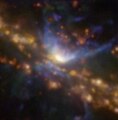File:A black hole caught blowing a gust (potw2206c).jpg

Original file (598 × 610 pixels, file size: 76 KB, MIME type: image/jpeg)
Captions
Captions
Summary[edit]
| DescriptionA black hole caught blowing a gust (potw2206c).jpg |
English: Lurking about 70 million light years away from Earth in the constellation Grus, you will find the galaxy NGC 7582 — a spiral galaxy harbouring a supermassive black hole at its core. These images were captured as part of a study using the MUSE instrument on ESO’s Very Large Telescope (VLT) to uncover the effect of an active black hole on the formation of stars in the galaxy.The galaxy contains an active galactic nucleus (AGN) — an extremely energetic central engine powered by the supermassive black hole gobbling up material in its immediate surroundings. Matter heats up in this process, launching huge amounts of energy and powerful winds into the surrounding area. But what effect does this have on the galaxy at large? To find out, a recent study, led by Stéphanie Juneau from NOIRLab in the USA, looked at the distribution of different ionised elements in the galaxy. This image shows oxygen, nitrogen and hydrogen in blue, green and red respectively. The red glowing areas are regions of high star formation activity, whereas the dominant blue regions show the cone-shaped material flowing out of the AGN. Compare it with this image, which covers the same area, shows a more classical view of this galaxy, with dust lanes obscuring blue and orange starlight.MUSE also allowed the team to map the motion of the stars and gas. They discovered that NGC 7582 may have a structure surrounding its central supermassive black hole that shields the rest of the galaxy from the harsh outflow of energy coming from the AGN, diverting it away from it in the form of an extremely powerful wind. |
||
| Date | Taken in 2022 | ||
| Source |
|
||
| Author | ESO / Juneau et al. | ||
| Other versions |
|
Licensing[edit]
 |
This media was created by the European Southern Observatory (ESO).
Their website states: "Unless specifically noted, the images, videos, and music distributed on the public ESO website, along with the texts of press releases, announcements, pictures of the week, blog posts and captions, are licensed under a Creative Commons Attribution 4.0 International License, and may on a non-exclusive basis be reproduced without fee provided the credit is clear and visible." To the uploader: You must provide a link (URL) to the original file and the authorship information if available. |
This file is licensed under the Creative Commons Attribution 4.0 International license.
| |
File history
Click on a date/time to view the file as it appeared at that time.
| Date/Time | Thumbnail | Dimensions | User | Comment | |
|---|---|---|---|---|---|
| current | 13:56, 20 August 2023 |  | 598 × 610 (76 KB) | OptimusPrimeBot (talk | contribs) | #Spacemedia - Upload of https://cdn.eso.org/images/large/potw2206c.jpg via Commons:Spacemedia |
You cannot overwrite this file.
File usage on Commons
The following page uses this file:
Metadata
This file contains additional information such as Exif metadata which may have been added by the digital camera, scanner, or software program used to create or digitize it. If the file has been modified from its original state, some details such as the timestamp may not fully reflect those of the original file. The timestamp is only as accurate as the clock in the camera, and it may be completely wrong.
| Credit/Provider | ESO / Juneau et al. |
|---|---|
| Source | European Southern Observatory |
| Short title |
|
| Image title |
|
| Usage terms |
|
| Date and time of data generation | 06:00, 7 February 2022 |
| Software used | Adobe Photoshop 23.1 (Windows) |
| File change date and time | 17:02, 26 January 2022 |
| Date and time of digitizing | 10:42, 24 January 2022 |
| Date metadata was last modified | 18:02, 26 January 2022 |
| Unique ID of original document | xmp.did:9ba488e0-bdd1-af45-ab52-95294f6b5e29 |
| Keywords | NGC 7582 |
| Contact information |
Karl-Schwarzschild-Strasse 2 Garching bei München, None, D-85748 Germany |
| IIM version | 4 |
